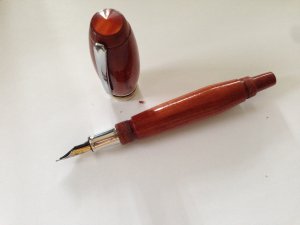BigNick73
Member
I've started my first kitless, section is done so I guess that's a start, and I'm running into a few questions for working with materials that don't thread well like wood or trustone.
First I was wondering how well the normal brass tubes tap/thread. I noticed 10mm tubes have a ID of 9.1mm which should be just prefect for a 10x1 tap, but its awful thin stuff and was wondering how it held up if tapped after being glued into a blank. I haven't checked sized but figure this might be a easy way to get threads in a cap as well without turning an insert.
For inserts I'm using 6061 aluminum since all I have is a wood lathe. Was wondering if most tend to make them the length of the barrel/cap or just an inch or so long in order to just get a good adhesive bond. I'm guessing the shorter version you'd have to leave the barrel/cap a bit thicker to have support.
And one more while I'm thinking about it, I threaded my section for a Jowo #6 nib, and while it's a super tight fit, I was wondering if it was normal to use a drop of CA or something to really secure it in there.
First I was wondering how well the normal brass tubes tap/thread. I noticed 10mm tubes have a ID of 9.1mm which should be just prefect for a 10x1 tap, but its awful thin stuff and was wondering how it held up if tapped after being glued into a blank. I haven't checked sized but figure this might be a easy way to get threads in a cap as well without turning an insert.
For inserts I'm using 6061 aluminum since all I have is a wood lathe. Was wondering if most tend to make them the length of the barrel/cap or just an inch or so long in order to just get a good adhesive bond. I'm guessing the shorter version you'd have to leave the barrel/cap a bit thicker to have support.
And one more while I'm thinking about it, I threaded my section for a Jowo #6 nib, and while it's a super tight fit, I was wondering if it was normal to use a drop of CA or something to really secure it in there.

